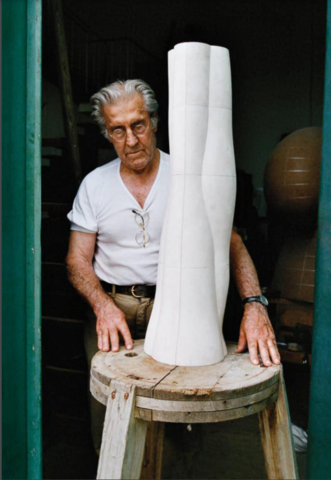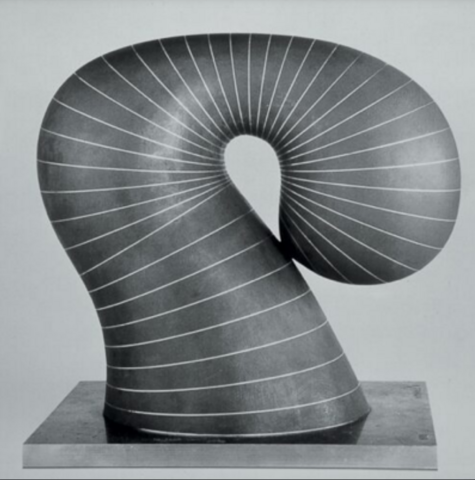
by Camilla Frank-Avramidis*
The Austro-Greek artist Joannis Avramidis, one of the most important protagonists of Greek and Austrian sculpture, was born in 1922 in Batumi, Georgia. Born into a family of ship owners and merchants, Avramidis soon commenced his art studies at the State Art School in Batumi at age 14, defying his father’s wishes.
Persecuted as a national minority by the Stalin regime in the late 1930s, the artist’s ethnically Greek father was labelled as “politically unreliable person” and murdered in 1937. Narrowly escaping the regime’s persecution, himself, Avramidis was unable to accept a scholarship offered to him by the Russian Academy of Arts in St. Petersburg and instead had to flee to Greece with his mother and younger siblings. Following this bid to evade further persecution, the then 17-year-old artist finished school whilst providing for his family in Athens.

The family’s relocation to Athens in 1939 served as the first pivotal juncture in Avramidis artistic development, representing a seminal encounter with Greek antiquity that profoundly influenced his future artistic creation. However, following the occupation of Greece by the National Socialists in 1941, the young artist was conscripted as a “foreign labourer” and deported to Vienna, Austria. Throughout the war’s duration, he forcibly laboured in a repair facility in the Viennese periphery, before facing suspicion from Soviet authorities due to his proficiency in Russian, leading to his deportation to an internment camp near Budapest. Managing to escape, the artist returned to Vienna to resume studying painting at the Academy of Fine Arts under Robin Christian Andersen and subsequently sculpture with his colleague Fritz Wotruba.

In his early painting, concentrated on reduced landscape depictions and intimist subjects, Avramidis exhibits an affinity for melancholic moods commonly associated with pittura metafisica. Starting in 1953, Avramidis solely focused on sculpture, with his earliest works now housed at the National Gallery in Athens.
Avramidis’ figural works centre around the idea of the human figure, drawing a constant between his early works in stone and later works in aluminum, bronze and other materials. Influenced by his profound connection to Greek antiquity, the artist’s sculptures contain elements from archaic and cycladic art, combined with a geometric design derived from rigorous mathematical calculations and sketches. His schematically rendered sculptures exhibit a meticulously determined multi-axiality, distinguished by the simultaneous presence of vertical and horizontal elements, arranged in a pattern reminiscent of vertebrae, with a rhythmic repetition of these elements composing the overall volumes. Avramidis’ adherence for exact segmentation of limbs, as showcased in his nude drawings and proportion schemes for sculptures, underscores his commitment to precision and form.

Internationally recognised as one of the leading Greek-Austrian artists, the uniqueness of Avramidis’ sculptural creations has been exhibited and recognised on multiple occasions. After receiving the State Prize of Vienna’s Academy of Fine Arts, Avramidis exhibited at the Kassel Documenta of 1964 and 1977 and represented Austria at the XXVIII Biennale of Venice in 1962. On the latter occasion, Alberto Giacometti highly commended the ” quality and drama” of the young artist’s work. Giacometti’s friend Franco Russoli, directing Milan’s Pinacoteca di Brera at the time, reiterates, praising “the constantly recurring image of solitude, the search for a refuge in the embrace of humans who are trapped in their own inability to communicate.” in Avramidis’ works. Besides numerous solo and group exhibitions, Avramidis held professorships at the Vienna Academy of Fine Arts, succeeding Herbert Boeckl, at the Academy of Fine Arts in Hamburg and offers from the Berlin and Munich Academy of Fine Arts. Before becoming professor emeritus in 1992, Avramidis held positions as director of the Nudes and Sculpture Departments at the Academy of Fine Arts in Vienna. Honouring his Greek-Austrian roots, Avramidis upheld deep connections to both countries throughout his lifetime, gifting an extensive collection to the National Gallery in Athens in 1997 following a retrospective exhibition, joining both the Austrian Art Senate and being named a corresponding member of the Greek Academy of Fine Arts alongside the Bavarian Academy of Fine Arts.

Avramidis’ works are currently recognised for their quality and artistic impact, being exhibited internationally, including at the National Gallery in Athens, in front of the German Bundestag and in private and public spaces across the world. Avramidis’ sculptural creations have received various awards and honours in Austria and internationally, including the Golden Decoration of Honour for Services to the Republic of Austria, the Austrian Decoration for Science and Art, the Grand State Prize and the Jerg-Ratgeb prize. The artist died in 2016 in Vienna, surrounded by family.
___
*Having graduated from University College London and Sciences Po Paris with a degree in the natural and political sciences, Camilla currently works in her family office, managing the works and legacy of Greek-Austrian artist Joannis Avramidis. Camilla aspires to use her Greek-Austrian heritage to promote cultural exchange and foster international dialogue.
All pictures gratis Camilla Frank-Avramidis.





